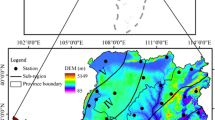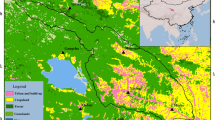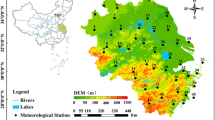Abstract
Reference evapotranspiration (ET0) is an important parameter of agricultural activity and hydro-meteorological studies. In this study, we used the Food and Agriculture Organization Penman–Monteith equation to evaluate ET0, and to investigate the change point of ET0 in the Loess Plateau region from 1960 to 2013. The results showed that a change point was detected at approximately the year 1990 for annual ET0 series from 108 meteorological stations using Cramer’s statistical test. The annual ET0 decreased significantly (p < 0.05) by −1.22 mm year−1 from 1960 to 1990, especially during the summer months, which contributed the most to the total annual reduction, while it increased significantly (p < 0.001) by 1.15 mm year−1 from 1991 to 2013, with the spring months contributing the most. The ET0 and its trend in the five integrated management divisions of the Loess Plateau have significant spatial heterogeneity. The highest and lowest ET0 were found in the third and fifth divisions from 1960 to 2013. The ET0 decreased significantly in the first division and increased in the fourth divisions (1960–1990 and 1991–2013, respectively). Using differential equations to quantitatively evaluate the contribution of various factors, the wind speed was mostly responsible for the variability in the ET0 trend from 1960 to 1990, followed by solar radiation and vapor pressure. The positive effect of air temperature on ET0 trend was offset by the other three factors, and the combined effects of the four climatic variables led to the decrease in the ET0 trend. However, the rapidly increasing air temperature became the predominant factor in the change in the ET0 trend after 1990. A spatiotemporal variation of predominant contribution to the ET0 trend was identified. The temperature dominant region changed from the third to the first division for 1960–1990 and 1991–2013. Radiation did not change. Vapor pressure changed from the first to the fourth and the wind speed changed from the forth to the third. This study could contribute to a better understanding of the response of the spatial and temporal variation of ET0 to increased climate change. Additionally, this research also provides scientific support to regional planning and management.






Similar content being viewed by others
References
Allen RG, Pereira LS, Raes D, Smith M (1998) Crop evapotranspiration—guidelines for computing crop water requirements—FAO Irrigation and drainage paper 56. FAO
Bennett MT (2008) China’s sloping land conversion program: institutional innovation or business as usual? Ecol Econ 65(4):699–711. doi:10.1016/j.ecolecon.2007.09.017
Bormann H (2011) Sensitivity analysis of 18 different potential evapotranspiration models to observed climatic change at German climate stations. Clim Change 104(3–4):729–753. doi:10.1007/s10584-010-9869-7
Brutsaert W, Parlange M (1998) Hydrologic cycle explains the evaporation paradox. Nature 396:30. doi:10.1038/23845
Cai XT et al (2014) Assessment of simulated water balance from Noah, Noah-MP, CLM, and VIC over CONUS using the NLDAS test bed. J Geophys Res Atmos 119:13751–13770. doi:10.1002/2014JD022113
Chen SB, Liu YF, Axel T (2006) Climatic change on the Tibetan Plateau: potential evapotranspiration trends from 1961–2000. Clim Change 76(3–4):291–319
Cong Z, Yang D, Ni G (2009) Does evaporation paradox exist in China? Hydrol Earth Syst Sci 13(3):357
Cong ZT, Zhao JJ, Yang DW (2010) Understanding the hydrological trends of river basins in China. J Hydrol 388:350–356
Dai L et al (2013) The spatial variation of alpine timberlines and their biogeographical characteristics in the northern Tianshan Mountains of China. Environ Earth Sci 68(1):129–137. doi:10.1007/s12665-012-1721-0
FAO (2010) Global forest resources assessment 2000 main report, 140. FAO Forestry Paper, Rome
Gao G, Chen DL, Ren GY, Chen Y, Liao YM (2006) Spatial and temporal variations and controlling factors of potential evapotranspiration in China: 1956–2000. J Geogr Sci 16(1):3–12
Gifford RM, Farquhar GD, Roderick ML, Nicholls N (2005) Workshop summary on pan evaporation: An example of the detection and attribution of climate change variables. Australia Academy of Sciences, pp 22–23
Gilgen H, Roesch A, Wild M, Ohmura A (2009) Decadal changes in shortwave irradiance at the surface in the period from 1960 to 2000 estimated from Global Energy Balance Archive Data. J Geophys Res Atmos. doi:10.1029/2008JD011383
Golubev VS et al (2001) Evaporation changes over the contiguous US and the former USSR: a reassessment. Geophys Res Lett 28(13):2665–2668. doi:10.1029/2000GL012851
Guo H, Xu M, Hu Q (2011) Changes in near-surface wind speed in China: 1969–2005. Int J Climatol 31:349–358. doi:10.1002/joc.2091
Heydari M, Tajamoli A, Ghoreishi S, Darbe-Esfahani M, Gilasi H (2014) Evaluation and calibration of Blaney-Criddle equation for estimating reference evapotranspiration in semiarid and arid regions. Environ Earth Sci. doi:10.1007/s12665-014-3809-1
Huang M, Zhang L, Gallichand J (2003) Runoff responses to afforestation in a watershed of the Loess Plateau, China. Hydrol Process 17(13):2599–2609. doi:10.1002/hyp.1281
Integrated Survey Team of Chinese Academy of Sciences (CAS) of the Loess Plateau (1992) Dataset of Resources, Environment and Society for the Loess Plateau Region (in Chinese). China Economic Publishing House, Beijing
IPCC (2013) Summary for Policymakes: The Physical Science Basis, Contribution of Working Group I to the IPCC Fifth Assessment Report Climate Change
Ishak AM, Remesan R, Srivastava PK, Islam T, Han D (2013) Error correction modelling of wind speed through hydro-meteorological parameters and mesoscale model: a hybrid approach. Water Resour Manag 27(1):1–23
Jhajharia D, Dinpashoh Y, Kahya E, Singh VP, Fakheri-Fard A (2012) Trends in reference evapotranspiration in the humid region of northeast India. Hydrol Process 26(3):421–435. doi:10.1002/hyp.8140
Jinbai H, Jiawei W, Osamu H, Hiroshi Y (2014) Runoff and water budget of the Liudaogou Catchment at the wind–water erosion crisscross region on the Loess Plateau of China. Environ Earth Sci 72(9):3623–3633. doi:10.1007/s12665-014-3273-y
Jung M et al (2010) Recent decline in the global land evapotranspiration trend due to limited moisture supply. Nature 467(7318):951–954
Kendall MG (1948) Rank correlation methods. Griffin, Oxford, England
Krüger O, Graßl H (2002) The indirect aerosol effect over Europe. Geophys Res Lett 29(19):31-1–31-4. doi:10.1029/2001GL014081
Li Z, Zheng F, Liu W, Flanagan DC (2010) Spatial distribution and temporal trends of extreme temperature and precipitation events on the Loess Plateau of China during 1961–2007. Quatern Int 226: 92–100. doi:10.1016/j.quaint.2010.03.003
Li Z, Zheng F, Liu W (2012) Spatiotemporal characteristics of reference evapotranspiration during 1961–2009 and its projected changes during 2011–2099 on the Loess Plateau of China. Agric For Meteorol 154–155:147–155. doi:10.1016/j.agrformet.2011.10.019
Li X, Liu L, Duan Z, Wang N (2014a) Spatio-temporal variability in remotely sensed surface soil moisture and its relationship with precipitation and evapotranspiration during the growing season in the Loess Plateau, China. Environ Earth Sci 71(4):1809–1820. doi:10.1007/s12665-013-2585-7
Li XP, Wang L, Chen DL, Yang K, Wang AH (2014b) Seasonal evapotranspiration changes (1983–2006) of four large basins on the Tibetan Plateau. J Geophys Res Atmos 119:13079–13095. doi:10.1002/2014JD022380
Liu C, Zeng Y (2004) Changes of pan evaporation in the recent 40 years in the Yellow River Basin. Water Int 29(4):510–516
Liu X, Zhang D (2013) Trend analysis of reference evapotranspiration in Northwest China: the roles of changing wind speed and surface air temperature. Hydrol Process 27(26):3941–3948. doi:10.1002/hyp.9527
Liu M, Shen Y, Zeng Y, Liu C (2010a) Trend in pan evaporation and its attribution over the past 50 years in China. J Geogr Sci 20(4):557–568
Liu Q, Yang Z, Cui B, Sun T (2010b) The temporal trends of reference evapotranspiration and its sensitivity to key meteorological variables in the Yellow River Basin, China. Hydrol Process 24(15):2171–2181. doi:10.1002/hyp.7649
Liu X, Luo Y, Zhang D, Zhang M, Liu C (2011a) Recent changes in pan-evaporation dynamics in China. Geophys Res Lett. doi:10.1029/2011GL047929
Liu X, Zheng H, Zhang M, Liu C (2011b) Identification of dominant climate factor for pan evaporation trend in the Tibetan Plateau. J Geogr Sci 21(4):594–608. doi:10.1007/s11442-011-0866-1
Liu X, Liu C, Luo Y, Zhang M, Xia J (2012a) Dramatic decrease in streamflow from the headwater source in the central route of China’s water diversion project: Climatic variation or human influence? J Geophys Res Atmos. doi:10.1029/2011JD016879
Liu C, Zhang D, Liu X, Zhao C (2012b) Spatial and temporal change in the potential evapotranspiration sensitivity to meteorological factors in China (1960–2007). J Geogr Sci 22(1):3–14. doi:10.1007/s11442-012-0907-4
Liu X, Liu W, Xia J (2013) Comparison of the streamflow sensitivity to aridity index between the Danjiangkou Reservoir basin and Miyun Reservoir basin, China. Theor Appl Climatol 111(3–4):683–691. doi:10.1007/s00704-012-0701-3
Lloyd CD (2005) Assessing the effect of integrating elevation data into the estimation of monthly precipitation in Great Britain. J Hydrol 308(1–4):128–150. doi:10.1016/j.jhydrol.2004.10.026
Lu GY, Wong DW (2008) An adaptive inverse-distance weighting spatial interpolation technique. Comput Geosci UK 34(9):1044–1055
McVicar TR et al (2007) Spatially distributing monthly reference evapotranspiration and pan evaporation considering topographic influences. J Hydrol 338(3):196–220
McVicar TR et al (2012) Global review and synthesis of trends in observed terrestrial near-surface wind speeds: implications for evaporation. J Hydrol 416(3):182–205
Meng D, Mo X (2012) Assessing the effect of climate change on mean annual runoff in the Songhua River basin, China. Hydrol Process 26(7):1050–1061. doi:10.1002/hyp.8180
Minderlein S, Menzel L (2015) Evapotranspiration and energy balance dynamics of a semi-arid mountainous steppe and shrubland site in Northern Mongolia. Environ Earth Sci 73(2):593–609. doi:10.1007/s12665-014-3335-1
New M, Hulme M, Jones P (2000) Representing twentieth-century space-time climate variability. Part II: development of 1901–96 monthly grids of terrestrial surface climate. J Clim 13(13):2217–2238
Papaioannou G, Kitsara G, Athanasatos S (2011) Impact of global dimming and brightening on reference evapotranspiration in Greece. J Geophys Res Atmos 116(D9):D09107. doi:10.1029/2010JD015525
Peterson TC, Golubev VS, Groisman PY (1995) Evaporation losing its strength. Nature 377(6551):687–688
Qian T, Dai A, Trenberth KE, Oleson KW (2006) Simulation of global land surface conditions from 1948 to 2004. Part I: forcing data and evaluations. J Hydrometeorol 7(5):953–975. doi:10.1175/JHM540.1
Roderick ML, Farquhar GD (2002) The cause of decreased pan evaporation over the past 50 years. Science 298(5597):1410–1411. doi:10.1126/science.1075390-a
Roderick ML, Farquhar GD (2005) Changes in New Zealand pan evaporation since the 1970s. Int J Climatol 25(15):2031–2039. doi:10.1002/joc.1262
Roderick ML, Rotstayn LD, Farquhar GD, Hobbins MT (2007) On the attribution of changing pan evaporation. Geophys Res Lett 34(17):251–270
Sentelhas PC, Gillespie TJ, Santos EA (2010) Evaluation of FAO Penman-Monteith and alternative methods for estimating reference evapotranspiration with missing data in Southern Ontario, Canada. Agric Water Manag 97(5):635–644. doi:10.1016/j.agwat.2009.12.001
Srivastava PK, Han D, Rico Ramirez MA, Islam T (2013) Comparative assessment of evapotranspiration derived from NCEP and ECMWF global datasets through weather research and forecasting model. AtScL 14(2):118–125. doi:10.1002/asl2.427
Srivastava PK, Han D, Rico-Ramirez MA, Islam T (2014) Sensitivity and uncertainty analysis of mesoscale model downscaled hydro-meteorological variables for discharge prediction. Hydrol Process 28(15):4419–4432. doi:10.1002/hyp.9946
Srivastava PK et al (2015a) Seasonal evaluation of evapotranspiration fluxes from MODIS satellite and mesoscale model downscaled global reanalysis datasets. Theor Appl Climatol:1–13. doi:10.1007/s00704-015-1430-1
Srivastava PK, Islam T, Gupta M, Petropoulos G, Dai Q (2015b) WRF dynamical downscaling and bias correction Schemes for NCEP estimated hydro-meteorological variables. Water Resour Manag 29(7):2267–2284
Tabari H, Marofi S, Aeini A, Talaee PH, Mohammadi K (2011) Trend analysis of reference evapotranspiration in the western half of Iran. Agric For Meteorol 151(2):128–136
Tang B, Tong L, Kang S, Zhang L (2011) Impacts of climate variability on reference evapotranspiration over 58 years in the Haihe river basin of north China. Agric Water Manag 98(10):1660–1670
TÜRkeŞ M (1996) Spatial and temporal analysis of annual rainfall variations in Turkey. Int J Climatol 16(9):1057–1076
Vautard R, Cattiaux J, Yiou P, Thepaut JN, Ciais P (2010) Northern Hemisphere atmospheric stilling partly attributed to an increase in surface roughness. Nat Geosci 3(11):756–761
Vetter S, Schaffrath D, Bernhofer C (2012) Spatial simulation of evapotranspiration of semi-arid Inner Mongolian grassland based on MODIS and eddy covariance data. Environ Earth Sci 65(5):1567–1574. doi:10.1007/s12665-011-1187-5
Wan H, Wang XL, Swail VR (2010) Homogenization and trend analysis of Canadian near-surface wind speeds. J Clim 23(5):1209–1225
Wang Y, Jiang T, Bothe O, Fraedrich K (2007) Changes of pan evaporation and reference evapotranspiration in the Yangtze River basin. Theor Appl Climatol 90(1):13–23
Wang QX, Fan XH, Wang MB (2011) Precipitation trends during 1961–2010 in the Loess Plateau region of China (in chinese). Acta Ecol Sin 31(19):5512–5523
Wang Qx, Fan Xh, Qin Zd, Wang Mb (2012) Change trends of temperature and precipitation in the Loess Plateau Region of China, 1961–2010. Glob Planet Change 92(4):138–147
Wild M (2009) Global dimming and brightening: a review. J Geophys Res Atmos 114:D00D16. doi:10.1029/2008JD011470
Wild M et al (2005) From dimming to brightening: decadal changes in surface solar radiation. Science 308:847–850. doi:10.1126/science.1103215
WMO (1996) Guide to meteorological instruments and methods of observation, 6th edn. WMO Rep. 8. World Meteorological Organization: Geneva
Wu Q, Yang W (1998) Forest and grassland vegetation construction and its sustainable development in Loess Plateau. China’s Science Press, Beijing
Xu C, Gong L, Jiang T, Chen D, Singh V (2006) Analysis of spatial distribution and temporal trend of reference evapotranspiration and pan evaporation in Changjiang (Yangtze River) catchment. J Hydrol 327(1):81–93
Xue Bl et al (2013) Evaluation of evapotranspiration estimates for two river basins on the Tibetan Plateau by a water balance method. J Hydrol 492(2013):290–297
Yin Y, Wu S, Zhao D (2013) Past and future spatiotemporal changes in evapotranspiration and effective moisture on the Tibetan Plateau. J Geophys Res Atmos. doi:10.1002/jgrd.50858
You Q et al (2010) From brightening to dimming in sunshine duration over the eastern and central Tibetan Plateau (1961–2005). Theor Appl Climatol 101(3–4):445–457. doi:10.1007/s00704-009-0231-9
Zeng Y, Qiu X, Pan A, Liu C (2008) Distributed modeling of global solar radiation over rugged terrain of the Yellow River Basin (in Chinese). Adv Earth Sci 23(11):1185–1193
Zhang P et al (2000) China’s forest policy for the 21st century. Science 288(5474):2135–2136
Zhang Y, Liu C, Tang Y, Yang Y (2007a) Trends in pan evaporation and reference and actual evapotranspiration across the Tibetan Plateau. J Geophys Res Atmos. doi:10.1029/2006JD008161
Zhang X et al (2007b) Modelling the impact of afforestation on average streamflow in the Loess Plateau, China. Hydrol Process 22:1996–2004. doi:10.1002/hyp.6784
Zhang Y, Chiew FHS, Zhang L, Leuning R, Cleugh HA (2008a) Estimating catchment evaporation and runoff using MODIS leaf area index and the Penman-Monteith equation. Water Resour Res 44(10):W10420. doi:10.1029/2007WR006563
Zhang X, Zhang L, Zhao J, Rustomji P, Hairsine P (2008b) Responses of streamflow to changes in climate and land use/cover in the Loess Plateau. Water Resour Res, China. doi:10.1029/2007WR006711
Zhang D, Liu X, Hong H (2013) Assessing the effect of climate change on reference evapotranspiration in China. Stoch Env Res Risk A 27(8):1871–1881. doi:10.1007/s00477-013-0723-0
Zhang D, Hong H, Zhang Q, Nie R (2014) Effects of climatic variation on pan-evaporation in the Poyang Lake Basin, China. Clim Res 61(1):29–40. doi:10.3354/cr01225
Zhao Y et al (2014) Spatio-temporal variation of reference evapotranspiration and aridity index in the Loess Plateau Region of China, during 1961–2012. Quatern Int 349:196–206. doi:10.1016/j.quaint.2014.06.050
Zheng H, Liu X, Liu C, Dai X, Zhu R (2009) Assessing contributions to panevaporation trends in Haihe River Basin,China. J Geophys Res Atmos 114(D24):D24105. doi:10.1029/2009JD012203
Zuo D, Xu Z, Yang H, Liu X (2012) Spatiotemporal variations and abrupt changes of potential evapotranspiration and its sensitivity to key meteorological variables in the Wei River basin, China. Hydrol Process 26(8):1149–1160
Acknowledgments
This research was financially supported by the Natural Science Foundation of China 41330529, 41501032 and 41301496.
Author information
Authors and Affiliations
Corresponding author
Rights and permissions
About this article
Cite this article
Li, Y., Liang, K., Bai, P. et al. The spatiotemporal variation of reference evapotranspiration and the contribution of its climatic factors in the Loess Plateau, China. Environ Earth Sci 75, 354 (2016). https://doi.org/10.1007/s12665-015-5208-7
Received:
Accepted:
Published:
DOI: https://doi.org/10.1007/s12665-015-5208-7




